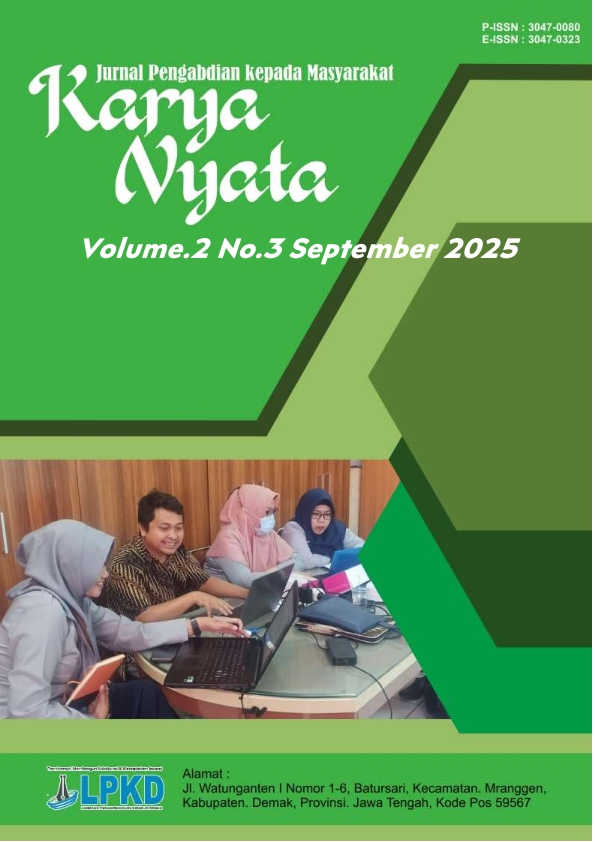Optimalisasi Pemanfaatan Limbah Pisang untuk Produksi Kompos Organik dalam Program KKN UNIWARA 2025
DOI:
https://doi.org/10.62951/karyanyata.v2i3.2144Keywords:
Banana, Compost, Organic, Utilization of organic waste, WasteAbstract
Kebonagung hamlet in Sukolelo village is an area where the majority of residents cultivate bananas. The abundant banana production generates a considerable amount of waste, one of which is banana stems that are usually piled up, burned, or left to rot without further use. Therefore, this community service project aims to provide a comprehensive overview of the potential use of banana waste as raw material for organic compost in Kebonagung Hamlet, Sukolelo Village. The methods used in this study involved banana farmers as research subjects and banana stems as research objects, with data collection techniques including field observations, interviews with farmers, and composting experiments. Simple laboratory analysis shows that compost from banana waste contains 1.8% nitrogen (N), 0.9% phosphorus (P), and 2.3% potassium (K), making it highly potential for use as compost material. In addition, composting activities can create new jobs through the development of organic fertilizer management business units at the village level. This is in line with Sustainable Development Goal (SDG) 12 on responsible consumption and production. According to Santoso (2020), the benefits of compost include: (a) improving soil structure, (b) increasing soil water storage capacity, (c) increasing soil microbial activity, and (d) reducing dependence on chemical fertilizers. Qualitative data were analyzed through data reduction, data presentation, and conclusion drawing in the form of nutrient content analyzed using simple laboratory tests to determine the levels of N, P, and K. The banana waste composting process went well. In the first week, the temperature of the compost pile increased to 45°C, indicating high microorganism activity. The temperature stabilized at around 50–55°C. After the second week, the temperature decreased and stabilized close to the ambient temperature, indicating that the compost was mature.
References
Anwar, F. (2020). Efektivitas kompos dari limbah pisang. Jurnal Agroforestri, 6(1), 22–30.
Badan Pusat Statistik. (2023). Statistik tanaman buah-buahan Indonesia. BPS.
Fauzi, A. (2018). Pertanian organik dan lingkungan. UMM Press.
Handayani, I. (2019). Kompos dan aplikasinya pada lahan pertanian. IPB Press.
Hidayat, T. (2020). Teknologi pengomposan untuk pertanian berkelanjutan. Bumi Aksara.
Kusuma, H. (2019). Analisis C/N ratio pada proses pengomposan. Jurnal Sains Tanah, 4(2), 98–106.
Nasution, H. (2020). Pemanfaatan limbah pertanian untuk kompos. Jurnal Agroekoteknologi, 12(2), 55–63.
Putri, L. (2021). Pembuatan kompos dari limbah pisang. Jurnal Pertanian Berkelanjutan, 7(1), 44–52.
Rahayu, S. (2021). Pertanian berkelanjutan melalui pemanfaatan kompos. Rajawali Pers.
Rahman, A. (2019). Analisis kandungan unsur hara pada kompos organik. Jurnal Sains Lingkungan, 5(3), 112–119.
Santoso, B. (2020). Pengaruh kompos terhadap kesuburan tanah. Jurnal Agro, 8(2), 33–41.
Setiawan, P. (2021). Pemanfaatan limbah organik untuk kompos. Jurnal Biologi Lingkungan, 10(2), 77–85.
Suryani, R. (2021). Pengelolaan limbah organik rumah tangga. Alfabeta.
Wahyuni, D. (2021). Teknologi tepat guna pengolahan limbah. Unesa Press.
Widodo, S. (2019). Dasar-dasar ilmu tanah dan kompos. Andi Offset.
Yuliana, M. (2020). Manajemen limbah pertanian. Universitas Negeri Semarang Press.
Downloads
Published
How to Cite
Issue
Section
License
Copyright (c) 2025 Karya Nyata : Jurnal Pengabdian kepada Masyarakat

This work is licensed under a Creative Commons Attribution-ShareAlike 4.0 International License.





